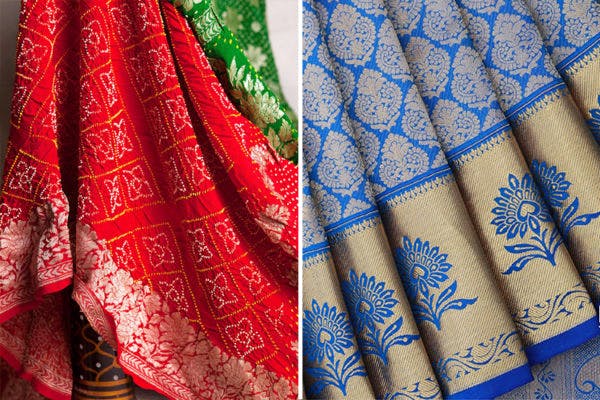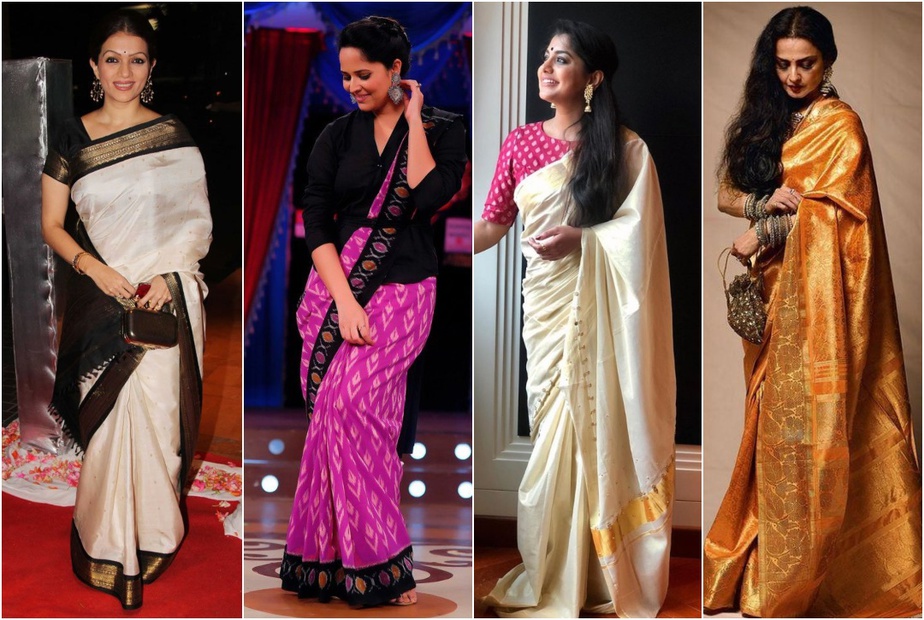

The saree, an iconic and traditional Indian garment, holds a special place in the heart of every Indian woman. It is not just a piece of cloth but a symbol of culture, grace, and heritage. India, a land of diverse cultures and traditions, is home to a mesmerizing array of sarees, each reflecting the unique essence of the region it hails from. Let's embark on a journey to explore the different types of sarees that adorn the diverse landscapes of India.
Originating from the city of Varanasi in Uttar Pradesh, Banarasi sarees are renowned for their opulence and intricate craftsmanship. These sarees are woven with luxurious silk and often feature elaborate gold and silver brocade work, creating a regal and timeless appeal. Banarasi sarees are a popular choice for weddings and special occasions, symbolizing elegance and grandeur.

Hailing from the temple town of Kanchipuram in Tamil Nadu, Kanjeevaram sarees are celebrated for their rich silk fabric and vibrant colors. These sarees are characterized by their broad borders and intricately woven motifs inspired by traditional temple art and nature. Kanjeevaram sarees are treasured as heirloom pieces, cherished by generations for their durability and beauty.
Originating from the town of Chanderi in Madhya Pradesh, Chanderi sarees are known for their lightweight and sheer texture. They are traditionally woven with a mix of silk and cotton yarn, adorned with delicate zari work or handcrafted motifs. Chanderi sarees exude a subtle elegance, making them ideal for both formal and casual occasions.
Hailing from the colorful state of Gujarat and Rajasthan, Bandhani sarees are a sight to behold. These sarees are tie-dyed with intricate patterns, achieved by tying small sections of the fabric before dyeing. The result is a stunning array of dots and patterns, creating a playful and vibrant look. Bandhani sarees are favored during festive celebrations and add a touch of vivacity to any occasion.

Another gem from Gujarat, Patola sarees are an epitome of artistic finesse and precision. These sarees are handwoven with dyed silk threads, meticulously creating intricate geometrical patterns and designs. Patola sarees are known for their reversible nature, displaying different patterns on each side, making them a valuable and prized possession.
Hailing from West Bengal, Taant sarees are a popular choice for their comfort and simplicity. These sarees are woven with cotton threads, often featuring broad borders with subtle designs. Taant sarees are perfect for daily wear and are lightweight, making them ideal for the hot and humid climate of the region.
From the town of Pochampally in Telangana, Pochampally sarees are known for their stunning geometric patterns and vibrant hues. These sarees are woven using the Ikat technique, where the yarn is resist-dyed before weaving to create mesmerizing designs. Pochampally sarees showcase the true essence of Indian craftsmanship and are a popular choice among saree enthusiasts.
ALSO READ:
The world of Indian sarees is a kaleidoscope of elegance, reflecting the rich cultural heritage and diversity of the country. Each region boasts its unique style and technique, making Indian sarees a treasure trove of artistry and craftsmanship. Whether it's the regal Banarasi, the vibrant Bandhani, or the delicate Chanderi, each saree tells a story and brings forth the beauty of Indian tradition. These timeless garments continue to be cherished and adorned by women, upholding the legacy of Indian sarees as a symbol of grace, beauty, and tradition.